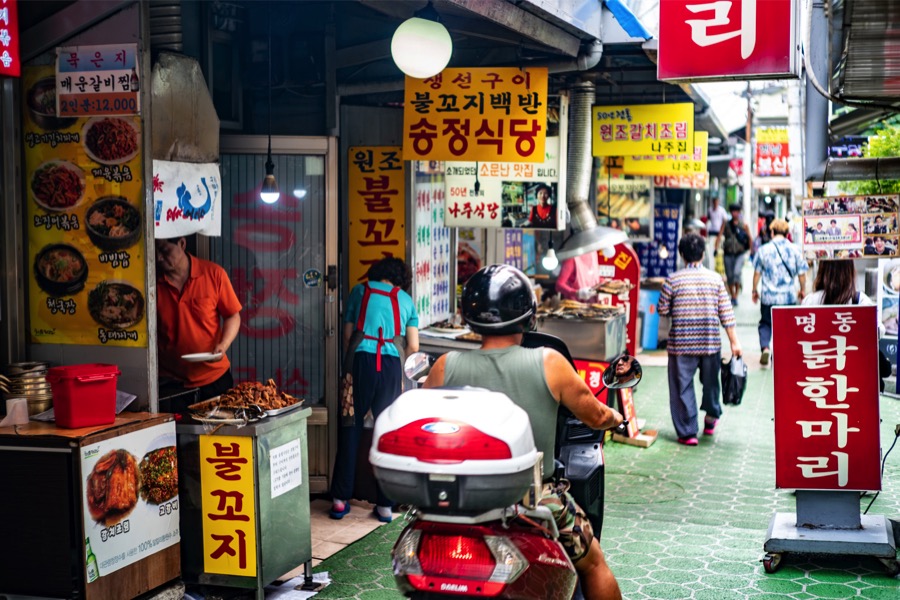SHARE
INFO
- DATE: 15-11-2020
- PLACE: Seoul
COUNTRY OF PROVENANCE

South Korea
RELATED ARTICLES

Gastronomy: a journey through the senses – Alessandra in South Korea
What it takes to make a new city a “home” is a good relationship with the culinary local culture. Alessandra, South Korea

The girl on the 22nd floor – Alessandra in South Korea
I’ve always lived on the second or third floor of low-rise buildings. From the twenty-second floor, what is far away is much sharper. Alessandra, South Korea

My Tips – Seoul, South Korea
Seoul is a city to live rather than visit. Choose carefully where to go during the day and in the evening. What to see – my Tips – Seoul, South Korea
From the traditional market to the home delivery
Alessandra from Seoul, South Korea
Tradition and avant-garde: fusion or contrast?
What immediately strikes the tourist and the expat in Seoul is the contrast between old and new, tradition and avant-garde. Blocks of skyscrapers – Seoul is the city with the highest density of skyscrapers in the world – together with traditional buildings, hanoks, inhabited or transformed into restaurants and shops. Additionally, large supermarkets co-exist with traditional markets, one in each dong (neighborhood). Paradise for ajoummas engaged in cleaning vegetables and selling kimchi. Women, the ajoummas, capable to rest in positions similar to the ones assumed by contorsionists.

Tasting paradise
Although the market continues to be one of the vital centers for Koreans, it is also one of the symbols of generational separation. Indeed, it is rare to cross there young people, who, instead, crowd the aisles of large supermarkets. Notably, they are mainly couples and families engaged in the hunt for local and foreign products. Furthermore, musical jingles, identifying the chain, are transmitted in a loop. They penetrate the brain, while ajoummas scream into their microphones and behind the visors how delicious is the product they promote. But not only: they invite you to taste! As an example, few days after my arrival in the city, I took a tour at emart – one of the major chains – just before dinner time. Consequentely, dinner was postponed to the next day!

The market: generational and geographical divisions
When I moved to Seoul, this generational split – of which the choice between the supermarket and the market is just one of many examples – struck me and generated reflections, which extend to lifestyle in general. In my Italian view, the market has always represented the access to genuine products, directly from the producer and at affordable and negotiable prices. Afterwards, in Switzerland, this idea has undergone a small transformation due to jewelry prices. Despite this, in my country of origin and in that of first adoption, I have always observed the presence of young people in the markets, increasingly attentive to the quality of the products, their perfumes, human contact with the seller and the reduction of packaging for the sake of the environment. In other words, an approach halfway between hipster and radical chic that I have not found in Korea.

Slow vs Fast times
On the contrary, the slow time of the market almost seems to be a symbol of that past that young people do not seem to appreciate. Why? Do they not know it well enough or do they know it too much from recent history? Why does life travel at the same speed as the internet connection and slowing down makes almost as nervous as a failed upload? In any case, the contrast between the slow times of the traditional market and the frenzy of the supermarket is almost canceled by the appearance of one of the major protagonists in Korean life: home delivery. Indeed, Korea is well-known for its wide array of delivery services, although its efficiency is directly proportional to the generation of packaging waste. As revealed by the number of apps and figures, it does not only regard supermarkets, but also restaurants and any kind of commercial activity.
The key of success
According to my experience, delivery times vary from 45mins / 1 hour for restaurants, a few hours for supermarkets, with the option to choose the delivery day, and from few to 48 hours for other consumer goods. What if you can’t be at home for the delivery? No problem: among the options you can ask to leave your order in front of the door. A notification is sent directly to your phone once done. Everything looks great, but I believe I know what you would ask me now. Well, the answer is “No”. Indeed, nobody touches or steals your orders. More precisely, these services can exist and be so efficient because of Korean respectful culture on the one hand, and security surveillance on the other hand. Hence, everything contributes to make this country one of the safest in the world.

Who? Where? How?
Let’s focus on meal delivery for the moment. Notably, convenience is the key. You can have any type of food you can possibly imagine, delivered straight away, no matter of time and place: home, office, university campus, or even outdoors like parks. As a matter of fact, Korea has one of the strongest and most advanced food delivery industries in the whole world. Figures show that the main users of these services are university students and workers between 20 and 40 years of age. Among them, singles account for the highest percentage of requests. It seems likely that the reason is not simply the intense working life but, above all, the poor distribution in supermarkets of fresh products in a different format than “family” packages and at low cost.
Reality or illusion?
Surely, I can confirm. As far as I remember, my first time in a supermarket I spent 30 minutes looking for a scale to conclude that for most of the fresh products there is no weight option. Then, their cost gave me the coup de grace. Summarizing, whatever the motivation, the keywords in Korea daily life are “convenience and efficiency”. Fast times to have more time. Reality or illusion?
For more information check this article out
You can check out my pictures on flickr here.
